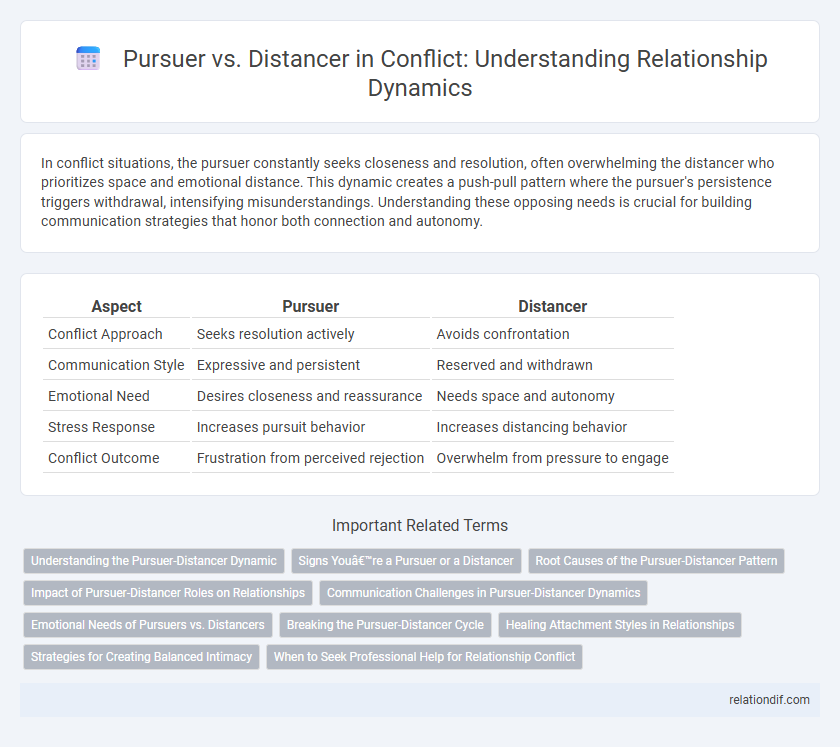In conflict situations, the pursuer constantly seeks closeness and resolution, often overwhelming the distancer who prioritizes space and emotional distance. This dynamic creates a push-pull pattern where the pursuer's persistence triggers withdrawal, intensifying misunderstandings. Understanding these opposing needs is crucial for building communication strategies that honor both connection and autonomy.
Table of Comparison
| Aspect | Pursuer | Distancer |
|---|---|---|
| Conflict Approach | Seeks resolution actively | Avoids confrontation |
| Communication Style | Expressive and persistent | Reserved and withdrawn |
| Emotional Need | Desires closeness and reassurance | Needs space and autonomy |
| Stress Response | Increases pursuit behavior | Increases distancing behavior |
| Conflict Outcome | Frustration from perceived rejection | Overwhelm from pressure to engage |
Understanding the Pursuer-Distancer Dynamic
The pursuer-distancer dynamic emerges as a common conflict pattern where one partner seeks closeness and communication while the other withdraws to maintain space and independence. This interaction often leads to escalating tension, as the pursuer's attempts to engage increase the distancer's desire to retreat, creating a cycle of frustration and misunderstanding. Recognizing this pattern allows couples to foster empathy, improve communication strategies, and balance needs for both connection and autonomy.
Signs You’re a Pursuer or a Distancer
Signs you're a pursuer include constantly seeking reassurance, initiating most conversations, and feeling anxious when your partner needs space. Distancers typically withdraw during conflicts, avoid emotional discussions, and prioritize independence over closeness, often creating emotional distance. Recognizing these patterns can help address communication breakdowns and improve relationship dynamics.
Root Causes of the Pursuer-Distancer Pattern
The root causes of the pursuer-distancer pattern often stem from deep-seated fears of abandonment and intimacy, where the pursuer seeks closeness to alleviate insecurity while the distancer withdraws to maintain autonomy and avoid vulnerability. Childhood attachment issues and past relational trauma frequently intensify these opposing drives, creating a cyclical conflict that perpetuates distance and frustration. Neurobiological responses to perceived threats in relationships, such as heightened cortisol levels and amygdala activation, further reinforce the pattern by triggering fight-or-flight behaviors.
Impact of Pursuer-Distancer Roles on Relationships
Pursuer-distancer dynamics significantly affect relationship stability by intensifying emotional distance and increasing conflict frequency. Pursuers seek closeness and reassurance, often triggering avoidance and withdrawal from distancers who value autonomy and space. This cyclical pattern perpetuates misunderstandings, reduces effective communication, and undermines trust, leading to prolonged dissatisfaction and emotional disconnection.
Communication Challenges in Pursuer-Distancer Dynamics
Communication challenges in Pursuer-Distancer dynamics often stem from mismatched needs, where the pursuer craves closeness and frequent interaction while the distancer seeks space and emotional autonomy. This push-pull pattern intensifies misunderstandings, as the pursuer interprets distance as rejection, and the distancer perceives pursuit as pressure. Effective conflict resolution requires recognizing these differing attachment styles and developing strategies that promote balanced communication and emotional regulation.
Emotional Needs of Pursuers vs. Distancers
Pursuers in conflict seek emotional closeness, validation, and reassurance, often driven by a fear of abandonment. Distancers prioritize independence, space, and emotional self-sufficiency, aiming to reduce perceived pressure and maintain autonomy. Understanding these contrasting emotional needs can improve communication and conflict resolution by addressing the root causes of each partner's behavior.
Breaking the Pursuer-Distancer Cycle
Breaking the Pursuer-Distancer cycle requires establishing clear boundaries and fostering open communication that addresses the underlying fears driving pursuit and withdrawal behaviors. Recognizing the emotional triggers of each role helps partners shift from reactive patterns to collaborative problem-solving, promoting mutual security. Consistent efforts to validate feelings and maintain emotional availability disrupt the cycle and pave the way for healthier conflict resolution.
Healing Attachment Styles in Relationships
Healing attachment styles in relationships involves understanding the dynamic between pursuer and distancer, where the pursuer seeks closeness and reassurance while the distancer values autonomy and space. Effective healing focuses on fostering secure attachment by promoting communication that validates emotions, establishes boundaries, and balances intimacy needs. Therapy techniques such as Emotionally Focused Therapy (EFT) and attachment-based interventions help partners build trust, reduce anxiety, and create a stable relational environment conducive to long-term healing.
Strategies for Creating Balanced Intimacy
Strategies for creating balanced intimacy between pursuers and distancers involve setting clear boundaries that respect each partner's need for closeness or space while fostering open communication to address underlying fears. Implementing regular check-ins encourages emotional safety and mutual understanding, allowing both parties to express needs without judgment. Prioritizing empathy and patience helps recalibrate interactions, preventing escalation and cultivating a secure, balanced connection.
When to Seek Professional Help for Relationship Conflict
Persistent patterns of pursuer-distancer conflict often signal the need for professional help, especially when communication breaks down and emotional distance increases. Couples may benefit from therapy when attempts to resolve disagreements escalate into frequent arguments or avoidance behaviors. Early intervention by licensed counselors or therapists can provide strategies to restore balance and improve relational dynamics.
pursuer vs distancer Infographic

 relationdif.com
relationdif.com